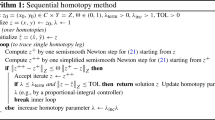Abstract
A fundamental homotopy-based linear programming algorithm, which utilizes Euler-predictor and Newton-corrector steps with restarts, is formulated and investigated numerically on problems representative of linear programs that arise in practice. A rich array of refinements of this basic algorithm are possible within the homotopy framework. Such refinements are needed in any practical implementation and are discussed in detail. Implications for the design of integrated large-scale mathematical programming software are also briefly considered.
Similar content being viewed by others
References
Chen, B., and Harker, P. (1990), A non-interior-point continuation method for linear complementarity problems, Decision Sciences Working Paper 90-10-03, Department of Management and Systems, Washington State University, WA.
Chvatal, V. (1983),Linear Programming, Freeman, New York.
Dantzig, G. B. (1963),Linear Programming and Extensions, Princeton University Press, Princeton, NJ.
Dennis, J. E., and Schnabel, R. B. (1983),Numerical Methods for Unconstrained Optimization and Nonlinear Equations, Prentice-Hall, Englewood Cliffs, NJ.
Ding, J., and Li, T. (1991), A polynomial-time predictor-corrector algorithm for a class of linear complementary problems,SIAM Journal on Optimization, 1, 83–92.
Garcia, C. B., and Zangwill, W. I. (1981),Pathways to Solutions, Fixed Points and Equilibria, Prentice-Hall, Englewood Cliffs, NJ.
Gay, D. M. (1985), Electronic mail distribution of linear programming test problems, Mathematical Programming Society COAL Newsletter, December, 1985.
Gill, P. E., Murray, W., Saunders, M. A., and Wright, M. H. (1986), Maintaining LU factors of a general sparse matrix, Technical Report SOL 86-8, Systems Optimization Laboratory, Department of Operations Research, Stanford University, Stanford, CA.
Golub, G. H., and Van Loan, C. F. (1989),Matrix Computations, 2nd edn., Johns Hopkins University Press, Baltimore, MD.
Hillier, F. S., and Lieberman, G. J. (1990),Introduction to Mathematical Programming, McGraw-Hill, New York.
Kahaner, D., Moler, C., and Nash S. (1989),Numerical Methods and Software, Series in Computational Mathematics, Prentice-Hall, Englewood Cliffs, NJ.
Kojima, M., Mizuno, S., and Yoshise, A. (1987), A primal-dual interior point algorithm for linear programming, Research Report No. B-188, Department of Information Sciences, Tokyo Institute of Technology, Tokyo.
Kojima, M., Megiddo, N., and Yoshise, A. (1990), Theoretical convergence of large-step primal-dual interior point algorithms for linear programming, Research Report RJ 7872, IBM Research Division, San Jose, CA.
Lustig, I. (1988), A generic primal-dual interior point algorithm, Technical Report SOR 88-3, Department of Civil Engineering and Operations Research, Princeton University, Princeton, NJ.
Lustig, I. (1988), Feasibility issues in an interior point method for linear programming, Technical Report SOR 88-9, Department of Civil Engineering and Operations Research, Princeton University, Princeton, NJ.
Lustig, I. J., Marsten, R. E., and Shanno, D. F. (1990), Computational experience with a primal-dual interior point method for linear programming, Technical Report SOR 89-17, Department of Civil Engineering and Operations Research, Princeton University, Princeton, NJ.
Lustig, I. J., Marsten, R. E., and D. F. Shanno (1990), On implementing Mehrotra's predictor-corrector interior point method for linear programming, Technical Report SOR 90-03, Department of Civil Engineering and Operations Research, Princeton University, Princeton, NJ.
Megiddo, N. (1986), Pathways to the optimal set in linear programming, Research Report RJ 5295, IBM Almaden Research Center, San Jose, CA. (Appears in N. Megiddo (ed.) (1989),Progress in Mathematical Programming, Springer-Verlag, New York, pp. 131–158.)
Mehrotra, S. (1990), The implementation of a (primal-dual) interior point method, Technical Report 90-03, Department of IE and Management Sciences, Northwestern University, Evanston, IL.
Nash, S. G. (1985), Preconditioning of truncated-Newton methods,SIAM Journal on Scientific and Statistical Computing,6, 599–616.
Nazareth, J. L. (1985), Hierarchical implementation of optimization methods, in P. Boggs, R. Byrd, and R.B. Schnabel (eds.),Numerical Optimization 1984, SIAM, Philadelphia, PA, pp. 199–210.
Nazareth, J. L. (1986), Homotopy techniques in linear programming,Algorithmica,1, 529–535.
Nazareth, J. L. (1986), Implementation aids for optimization algorithms that solve sequences of linear programs,ACM Transactions on Mathematical Software,12, 307–323.
Nazareth, J. L. (1987),Computer Solution of Linear Programs, Oxford University Press, Oxford.
Nazareth, J. L. (1989), The homotopy principle and algorithms for linear programming, International Institute for Applied Systems Analysis (IIASA) Workshop on Nonstandard Optimization and Related Topics, August 1–4, 1989, Laxenburg (appears inSIAM Journal on Optimization,1 (1991), 316–332.
Renegar, J., and Shub, M. (1988), Simplified complexity analysis for Newton LP methods, Report No. 807, School of Operations Research and Industrial Engineering, Cornell University, Ithaca, NY.
Smale S. (1982), The problem of the average speed of the simplex method, in A. Bachem, M. Grotschel and B. Korte (eds.),Mathematical Programming: The State of the Art, Bonn, 1982, Springer-Verlag, Berlin, pp. 530–539.
Smale, S. (1986), Algorithms for solving equations,Proceedings of the International Congress of Mathematicians, University of California, Berkeley, CA, pp. 87–121.
Tapia, R. A., Zhang, Y., Saltzman, M., and Weiser, A. (1990), The predictor-corrector interior-point method as a composite Newton method, Report TR90-17 (revised August 1991), Department of Mathematical Sciences, Rice University, TX.
Todd, M. J., and Vial, J.-P. (1990), Todd's low-complexity algorithm is a predictor-corrector path-following method, Report No. 952, School of Operations Research and Industrial Engineerring, Cornell University, Ithaca, NY.
Ye, Y. (1991), Improving the asymptotic convergence of interior-point algorithms for linear programming, Working Paper No. 91-15, Department of Management Sciences, The University of Iowa, Iowa City, IA.
Ye, Y., Tapia, R. A., and Zhang, Y. (1991), A superlinearly convergentO(√nL)-iteration algorithm for linear programming, Report TR91-22, Department of Mathematical Sciences, Rice University, TX.
Author information
Authors and Affiliations
Additional information
Communicated by N. Megiddo.
This research was supported by NSF Grant DMS-8815513, and first appeared, under the same title, as Technical Report 91-6 (October, 1991) issued by the department below.
Rights and permissions
About this article
Cite this article
Nazareth, J.L. The implementation of linear programming algorithms based on homotopies. Algorithmica 15, 332–350 (1996). https://doi.org/10.1007/BF01961543
Received:
Revised:
Issue Date:
DOI: https://doi.org/10.1007/BF01961543



